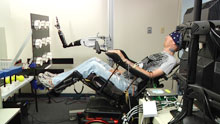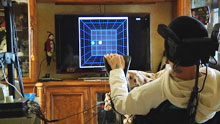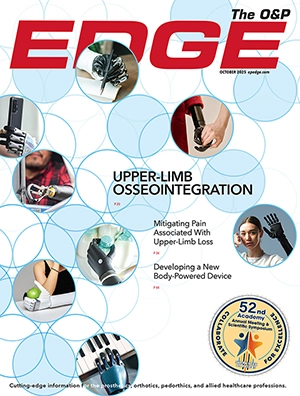Seven years after a motorcycle accident damaged his spinal cord and left him paralyzed, 30-year-old Tim Hemmes reached up to touch hands with his girlfriend.

As part of testing, Hemmes willed a robotic arm to reach for a ball placed onto specific areas of a board in front of him. Photographs courtesy of UPMC.
Hemmes, of Evans City, Pennsylvania, is the first to participate in a new trial assessing whether the thoughts of a person with spinal cord injury (SCI) can be used to control the movement of an external device, such as a computer cursor or a sophisticated prosthetic arm. The project, one of two brain-computer interface (BCI) studies underway at the University of Pittsburgh (Pitt) School of Medicine, Pennsylvania, and University of Pittsburgh Medical Center (UPMC) Rehabilitation Institute used a grid of electrodes placed on the surface of the brain to control the arm. The robotic arm and hand was designed by the Johns Hopkins University Applied Physics Laboratory (JHU APL), Baltimore, Maryland.
“I put my heart and soul into everything they asked me to do,” Hemmes said. “I got to reach out and touch somebody for the first time in seven years.”
“This first round of testing reinforces the great potential BCI technology holds for not only helping spinal cord-injured patients become more independent, but also enhancing their physical and emotional connections with their friends and family,” said co-principal investigator Michael Boninger, MD, director of the UPMC Rehabilitation Institute and professor and chair of the Department of Physical Medicine and Rehabilitation, Pitt School of Medicine. “It further motivates us to make this technology useful and available to those who need it.”
On August 25, an electrocortigraphy (ECoG) grid, about the size of a large postage stamp, adapted from seizure-mapping brain electrode arrays, was placed on the surface of Hemmes’ brain during a two-hour operation performed by co-investigator and UPMC neurosurgeon Elizabeth Tyler-Kabara, MD, PhD, assistant professor, Department of Neurological Surgery, Pitt School of Medicine.
“Before the procedure, we conducted several functional imaging tests to determine where his brain processed signals for moving his right arm,” she explained. “We removed a small piece of his skull and opened the thick layer of protective dura mater beneath it to place the grid over that area of motor cortex. We then put the dura and skull back with the wires on the outside of the skull but under the scalp.”
Tyler-Kabara tunneled the connecting wires under the neck skin to exit from the upper chest, where they could be periodically hooked up to computer cables. Six days per week for the next four weeks at home and on campus, Hemmes and the team tested the technology. The researchers used computer software they developed in earlier studies to interpret the neural signals sensed by the brain grid.

In addition to the arm testing, Hemmes used his thoughts to guide an image of a ball displayed on a large television screen.
After watching a computer-generated figure move an arm, Hemmes began trying to guide a ball from the middle of a large television screen either up, down, left, or right to a target, within a time limit. With practice, he could do this two-dimensional task without any computer assistance. He then performed a similar task with the arm, reaching out to touch a target on a large, desk-mounted panel. However, it wasn’t the simultaneous thought-and-move process that Hemmes knew before becoming paralyzed.
“He mentally associated specific motor imageries with desired movement direction,” said co-principal investigator Wei Wang, MD, PhD, assistant professor, Department of Physical Medicine and Rehabilitation, Pitt School of Medicine. “It required concentration and patience, but this process seemed to get easier for him with practice…. In future studies, we also will test other approaches, including the participant simply thinking up for up, down for down, and so on.”
After about eight sessions, Hemmes tackled more complicated tasks. While wearing special goggles to properly view a three-dimensional television screen, he moved the ball in the previous directions, and also to the front or back. He also practiced moving the arm in all directions, culminating in the moments after formal testing had been completed when he reached out to Wang and to his girlfriend. Tyler-Kabara removed the ECoG brain grid and wiring in a short operation the next day, September 22.
The researchers are now analyzing the data, and are seeking at least five more adults with SCI or brainstem strokes who have very little or no use of their hands and arms for additional studies.
For more information about the trials, call 800.533.8762.



